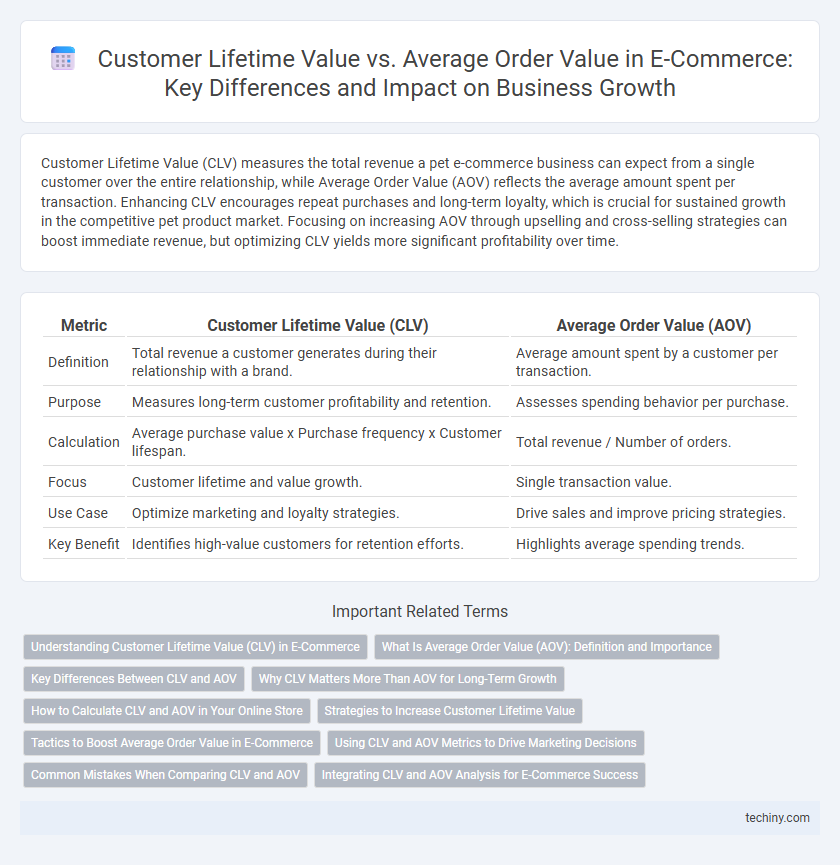Customer Lifetime Value (CLV) measures the total revenue a pet e-commerce business can expect from a single customer over the entire relationship, while Average Order Value (AOV) reflects the average amount spent per transaction. Enhancing CLV encourages repeat purchases and long-term loyalty, which is crucial for sustained growth in the competitive pet product market. Focusing on increasing AOV through upselling and cross-selling strategies can boost immediate revenue, but optimizing CLV yields more significant profitability over time.
Table of Comparison
| Metric | Customer Lifetime Value (CLV) | Average Order Value (AOV) |
|---|---|---|
| Definition | Total revenue a customer generates during their relationship with a brand. | Average amount spent by a customer per transaction. |
| Purpose | Measures long-term customer profitability and retention. | Assesses spending behavior per purchase. |
| Calculation | Average purchase value x Purchase frequency x Customer lifespan. | Total revenue / Number of orders. |
| Focus | Customer lifetime and value growth. | Single transaction value. |
| Use Case | Optimize marketing and loyalty strategies. | Drive sales and improve pricing strategies. |
| Key Benefit | Identifies high-value customers for retention efforts. | Highlights average spending trends. |
Understanding Customer Lifetime Value (CLV) in E-Commerce
Customer Lifetime Value (CLV) in e-commerce measures the total revenue a single customer is expected to generate over their entire relationship with a brand, providing deeper insights than Average Order Value (AOV), which only reflects the revenue from a single purchase. CLV helps businesses tailor marketing strategies, optimize customer retention, and allocate budgets more effectively to maximize profitability. Accurate CLV calculation incorporates purchase frequency, average order size, and customer lifespan, driving long-term growth and sustainable revenue streams.
What Is Average Order Value (AOV): Definition and Importance
Average Order Value (AOV) measures the average amount spent by customers per transaction in an e-commerce store, calculated by dividing total revenue by the number of orders. Understanding AOV helps businesses optimize pricing strategies, product bundling, and marketing efforts, directly impacting revenue growth. Tracking AOV alongside Customer Lifetime Value (CLV) provides a comprehensive view of customer purchasing behavior and long-term profitability.
Key Differences Between CLV and AOV
Customer Lifetime Value (CLV) measures the total revenue a customer generates over their entire relationship with a brand, while Average Order Value (AOV) calculates the average amount spent per transaction. CLV emphasizes long-term customer profitability and retention, whereas AOV focuses on immediate sales performance and transaction size. Understanding these key differences helps e-commerce businesses optimize marketing strategies, enhance customer loyalty, and increase overall revenue growth.
Why CLV Matters More Than AOV for Long-Term Growth
Customer Lifetime Value (CLV) measures the total revenue a customer generates over their entire relationship with an e-commerce brand, while Average Order Value (AOV) only reflects the revenue from a single transaction. Prioritizing CLV helps businesses invest in customer retention, personalized marketing, and loyalty programs that drive sustainable, long-term growth. Focusing solely on AOV can lead to short-term gains but misses opportunities to build lasting customer relationships and maximize profitability over time.
How to Calculate CLV and AOV in Your Online Store
Customer Lifetime Value (CLV) is calculated by multiplying the average purchase value, purchase frequency, and customer lifespan, providing insight into the total revenue a customer generates over time. Average Order Value (AOV) is determined by dividing total revenue by the number of orders placed during a specific period, reflecting the average amount spent per transaction. Accurate calculation of CLV and AOV enables e-commerce businesses to optimize marketing strategies and improve customer retention efforts.
Strategies to Increase Customer Lifetime Value
Boost Customer Lifetime Value (CLV) by implementing personalized marketing campaigns, loyalty programs, and subscription models that encourage repeat purchases and long-term engagement. Enhancing customer retention through exceptional customer service, targeted upselling, and cross-selling strategies increases overall profitability beyond single transactions measured by Average Order Value (AOV). Data-driven insights and segmentation enable tailored offers that maximize CLV, driving sustainable growth in e-commerce businesses.
Tactics to Boost Average Order Value in E-Commerce
Implementing tactics such as upselling complementary products, offering volume discounts, and providing free shipping thresholds effectively increases Average Order Value (AOV) in e-commerce. Personalizing product recommendations based on browsing and purchase history further encourages customers to add more items to their carts. Leveraging limited-time promotions and bundling popular products drives higher transaction values, ultimately enhancing overall revenue without solely relying on Customer Lifetime Value (CLV).
Using CLV and AOV Metrics to Drive Marketing Decisions
Customer Lifetime Value (CLV) measures the total revenue a customer generates across their entire relationship with a brand, while Average Order Value (AOV) calculates the average amount spent per transaction. Leveraging CLV allows e-commerce marketers to identify high-value customer segments, optimize retention strategies, and allocate budgets for long-term growth. Analyzing AOV helps in designing targeted promotions, upselling tactics, and personalized offers to increase immediate transaction value and improve overall profitability.
Common Mistakes When Comparing CLV and AOV
Confusing Customer Lifetime Value (CLV) with Average Order Value (AOV) leads to inaccurate revenue projections since CLV measures total revenue from a customer over time, while AOV reflects the value per single transaction. Mistaking AOV for CLV causes businesses to underestimate customer retention impact and overemphasize immediate sales, skewing marketing budget allocation. Ignoring the time dimension inherent in CLV when compared to the transaction-focused AOV results in flawed customer segmentation and targeting strategies.
Integrating CLV and AOV Analysis for E-Commerce Success
Integrating Customer Lifetime Value (CLV) and Average Order Value (AOV) analysis enables e-commerce businesses to optimize marketing budgets by identifying high-value customers with larger purchase sizes. Leveraging predictive CLV models alongside AOV segmentation enhances personalized marketing strategies, driving repeat purchases and maximizing revenue per customer. Data-driven integration of CLV and AOV metrics supports inventory management, targeted promotions, and customer retention for sustainable e-commerce growth.
Customer Lifetime Value vs Average Order Value Infographic

 techiny.com
techiny.com